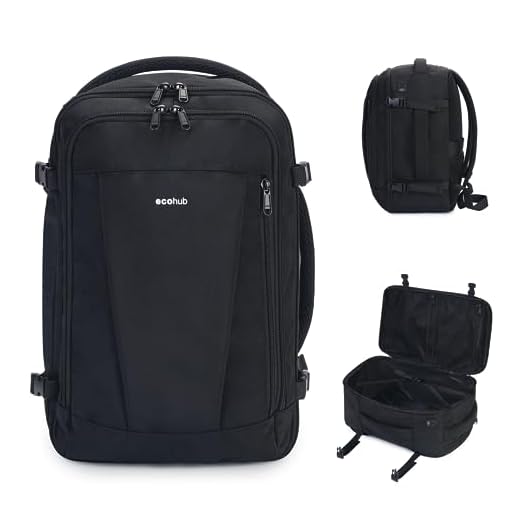







The maximum acceptable weight for hand baggage on global air travel ranges generally from 7 to 10 kilograms (15 to 22 pounds). However, specific airlines and routes may impose stricter or more lenient guidelines. It is critical to check the policies of your chosen carrier prior to traveling to avoid unexpected fees or issues at the airport.
In addition to the weight, size measurements also play a key role in suitability. Most entities allow dimensions close to 55 x 40 x 20 centimeters (21.5 x 15.7 x 7.9 inches). Carrying an item exceeding these measurements could lead to having to check it in or incurring additional charges.
For those traveling with special needs items, such as medical devices or infant supplies, airlines may provide exemptions or allowances. Always confirm with the airline ahead of time to ensure compliance and smooth boarding. Packing efficiently and utilizing a suitable travel bag can also maximize adherence to requirements.
Guidelines for Cabin Bag Dimensions
Maximum dimensions for personal items typically range from 15 to 20 inches in height and 10 to 15 inches in width. Standard cabin cases are generally allowed with measurements up to 22 x 14 x 9 inches, but regulations vary across carriers. Always verify specifics with the airline prior to your travel date.
Variances Among Airlines
Major carriers like American Airlines, Delta, and Lufthansa commonly impose restrictions, while low-cost airlines may adopt stricter rules. For example, Ryanair allows only a small item with dimensions capped at 15.7 x 7.9 x 9.8 inches. Assess your chosen carrier’s policy to avoid surprises at the airport.
Handling Overweight Items
When exceeding allowed specifications, options include checking the item in as baggage, redistributing contents into another bag, or making adjustments to avoid extra fees. Fees for oversize bags can range widely, from $50 to $200 or more, depending on the airline. Prior preparation is key to preventing added costs.
Understanding Airline-Specific Carry-On Policies
The maximum weight allowed varies across different carriers and destinations. Check each airline’s website for precise regulations, as these can differ significantly. Some may allow up to 10 kg, while others might have a tolerance for 8 kg or even more.
Common Allowances
Most airlines permit a personal item alongside the main piece of hand baggage. Personal items may include laptops, small backpacks, or purses. The dimensions often range from 40 cm x 30 cm x 15 cm to slightly larger sizes, depending on the company.
| Airline | Main Baggage Allowance | Personal Item Allowance |
|---|---|---|
| Airline A | 10 kg | 40 cm x 30 cm x 15 cm |
| Airline B | 7 kg | 55 cm x 40 cm x 20 cm |
| Airline C | 8 kg | 35 cm x 25 cm x 10 cm |
Specific Guidelines
Observe the following tips: check dimensions before packing, weigh your carry-on at home, and be aware that liquid restrictions apply. Liquids over 100 ml are typically prohibited in the main cabin. Arrive early to manage any last-minute adjustments at the airport.
Common Weight Limits for Major Airlines
Airlines commonly enforce specific restrictions on the maximum mass of items travelers can bring aboard. Here are approximate standards for several leading carriers:
American Airlines
Customers are generally allowed one piece weighing up to 40 pounds (18 kg), with dimensions not exceeding 22 x 14 x 9 inches (56 x 36 x 23 cm).
Delta Air Lines
Delta typically permits one item with a maximum mass of 40 pounds (18 kg), following size restrictions of 22 x 14 x 9 inches (56 x 36 x 23 cm).
United Airlines
Travelers can bring one personal item up to 40 pounds (18 kg), dimensionally constrained to 21 x 14 x 9 inches (53 x 36 x 23 cm).
British Airways
This airline allows one item weighing up to 51 pounds (23 kg) with a maximum dimension of 22 x 18 x 10 inches (56 x 45 x 25 cm).
Air France
Passengers are offered an allowance of one piece with a maximum mass of 40 pounds (18 kg), adhering to dimensions of 21.7 x 13.8 x 9.8 inches (55 x 35 x 25 cm).
Keep in mind that policies can shift, so it’s advisable to consult the carrier’s official website before travel for the latest updates.
Factors Influencing Carry-On Weight Restrictions
Passengers should consider various elements that affect the maximum allowed burden aboard aircraft. Common factors include:
- Airline Policies: Each carrier has its own set of guidelines regarding dimensions and mass. Checking with the specific service provider beforehand prevents surprises at check-in.
- Aircraft Type: Smaller planes typically have stricter standards due to limited overhead space, while larger aircraft may allow a greater amount.
- Route and Distance: Flights traveling longer distances might have less flexibility compared to shorter trips, as load requirements differ according to flight duration.
- Passenger Class: Premium classes may enjoy higher allowances as part of service perks, whereas economy travelers often face stricter rules.
- Regulatory Compliance: Government regulations may influence what aviation companies implement regarding personal items and weights.
To ensure you select appropriate containers for your travel needs, explore the best luggage to study abroad with. This guide offers suggestions tailored to various travel scenarios and airline conditions.
Measuring and Weighing Your Carry-On Items
First, use a reliable scale to check the mass of your items. A digital luggage scale provides accuracy and ease of use. Alternatively, place your bag on a household scale, ensuring the display shows the total weight. Regularly calibrate your scale for precise measurements.
Tips for Accurate Measurement
- Remove additional items from your bag before weighing.
- Ensure the scale is on a flat, stable surface.
- Weigh yourself holding the item, then subtract your weight.
Consider investing in a carry-on item with built-in scales to track mass on the go. This can help avoid surprises at check-in.
Utilizing Volume for Space Management
Measure the dimensions of your carry-on. Airlines often have restrictions based on size. Use a tape measure to verify width, height, and depth. Items exceeding the specified dimensions may need to be checked, even if they don’t surpass the weight criteria.
Pack strategically. Utilize packing cubes to maximize space and keep items organized. This method allows for efficient use of space, ensuring compliance with airline policies.
For additional information on unrelated topics, check out this link: how can a dentist tell if you suck dick.
Packing Tips to Stay Within Restrictions
Use a digital or handheld scale to precisely measure your bag before heading to the airport. This avoids surprises at check-in.
Choose the Right Bag
Select a lightweight carry-on that doesn’t consume much of your allowance. Look for materials that are durable yet light.
Prioritize Essentials
Pack only the necessary items such as travel documents, toiletries, and a change of clothes. Leave non-essentials behind to minimize bulk.
Roll clothing instead of folding to save space and allow for more items. Consider packing cubes to organize and compress your belongings.
Wear heavier shoes and clothing during travel. This shifts weight from your bag to your person, optimizing your allowance.
Utilize every available pocket and compartment in your carry-on. Store smaller items efficiently to maximize capacity without adding bulk.
Keep in mind that some airlines have specific size requirements. Double-check these dimensions and pack accordingly to avoid extra fees.
Finally, be mindful of liquids and gels. Stick to the regulations to save space while ensuring compliance with security checks.
What to Do If Your Carry-On Exceeds the Weight Limit
If the examining process reveals an excess in your bag’s mass, consider redistributing items into pockets or between fellow travelers if feasible. Prioritize essentials such as travel documents, medicine, and electronics for easy access.
Options for Handling Overages
Evaluate your belongings and remove non-essentials or duplications–items that can be purchased at your destination should be reconsidered. If adjustments don’t satisfy the maximum requirements, inquire whether checking the bag is viable without incurring steep fees.
Utilizing Airline Services
Some carriers offer the possibility to upgrade your existing ticket to accommodate additional gear. Check for promotions or seasonally available packages that might provide cost-effective solutions. Alternatively, consider options like shipping certain items ahead via postal services for a hassle-free experience upon arrival.
FAQ:
What is the general weight limit for carry-on luggage on international flights?
The typical weight limit for carry-on luggage on international flights varies by airline, but it usually ranges between 7 to 10 kilograms (15 to 22 pounds). It’s essential to check the specific airline’s policy before traveling, as different airlines and classes of service may have different restrictions. Additionally, some airlines may enforce size limitations as well as weight, so it’s advisable to ensure that your bag fits within the required dimensions.
Are there any items that can exceed the carry-on weight limit?
Generally, items like duty-free purchases, assistive devices, and specific medical equipment might not count towards the carry-on weight limit. However, this varies by airline. It’s recommended to contact the airline ahead of time to clarify their policies regarding excess items. Be mindful that these exceptions often come with mandatory verification or documentation to help streamline the boarding process.
What should I do if my carry-on luggage exceeds the weight limit?
If your carry-on luggage exceeds the weight limit, you have a few options. One option is to redistribute weight by moving some items to your checked luggage, if you have it. Alternatively, you might consider wearing heavier clothing or shoes to decrease the weight of your bag. If neither option works, you may need to pay a fee to your airline for the overweight carry-on, or, in some cases, you could be asked to check the bag. Always check your airline’s policy regarding fees to avoid surprises at the airport.








